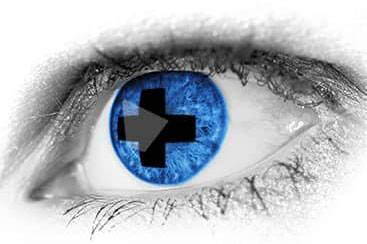Have you ever been at the scene of an accident and not known what to do to help the injured child or adult?
Note: This information does not replace an eye exam from a doctor. For any eye injury, we recommend contacting the nearest eye doctor or ER department.
When someone gets injured, it is not uncommon for those around them to jump into panic mode, run around in circles, raise their voice, and sometimes even do the opposite of what should really be done in the situation.
For all eye injuries always seek medical care, either from your eye doctor, primary care physician or ER department.
Panicking is not very helpful and usually causes the injured person to panic as well.
This guide is meant to help you know what to do in case of an emergency— specifically when it comes to an eye injury.
In some situations, an eye emergency is just that, an EMERGENCY.
While not all eye injuries require immediate medical attention, there are times when an eye injury can pose a risk of permanent eye damage and may even threaten vision loss.
So if you are ever near a child or adult who has been injured in the eye, stay calm and follow all medical advice.
Call your doctor immediately if the pain becomes severe, symptoms worsen or vision changes are noticed.
First aid for a foreign object in the eye
If a foreign body, such as a small particle of sawdust, grain of sand or blade of grass gets caught in the eye, it is important to avoid touching and rubbing the eye— and refrain from trying to remove it with your fingers.
These natural instincts can cause further damage— especially if the object is embedded in the eyelid. Removing the object on your own can also introduce bacteria into the eye, or make it more difficult to dislodge the object.
Instead, flush the eye with clean water or sterile saline solution. This can help to dislodge the object.
Then, have the eye examined by an eye care professional to ensure that the eye is clear of foreign matter and rule out a corneal abrasion that may require treatment.
If you have sustained an eye injury, head to the nearest emergency room for initial emergency treatment. In the event you cannot reach an emergency room, contact an eye doctor near you.
SEE RELATED: When is Blurred Vision a Medical Emergency?
What to do for minor eye injuries
- Small cuts, scratches or scrapes
-
- For any bleeding, put direct pressure on the wound using a gauze pad or clean cloth. Press for 10 minutes or until the bleeding has stopped.
- Wash the wound with soap and water for 5 minutes. Protect the eye with a clean cloth.
- Apply an over the counter antibiotic ointment 3 times a day, for 3 days.
- Cover large scrapes with a bandage. Change daily.
- Swelling or bruises with intact skin (Black Eye)
-
- Place a cold pack or ice wrapped in a wet cloth on the eye for 20 minutes several times a day. This will help stop the bleeding and swelling.
- After 48 hours, replace the cold compress with a warm wet cloth. Apply the warm compress to the eye 3 times per day for 10 minutes. This will help the eye tissue to reabsorb the blood.
- Minor discomfort or pain
- Take an over the counter pain reliever, such as acetaminophen or ibuprofen.
- Rest as much as possible.
First aid for toxic chemicals in the eye
For any chemicals that splash into the eyes, it is essential to seek emergency medical care to remove the chemicals correctly and to treat any damage to the eye a soon as possible.
Toxic chemicals found in cleaning sprays, detergents, bleach and other fluids can cause significant eye damage and permanent vision loss if they get into the eye. If a chemical has splashed into an eye, first read the label on the package before doing anything, and follow the first aid treatment instructions for that specific item.
If the bottle of chemicals is not labeled with first aid instructions, seek immediate medical attention.
This is important because your knee jerk reaction may be to run to the sink and put water on the eye, but some chemicals are more damaging when mixed with water!
If you are instructed to flush the eye with water, hold the person’s head under a running faucet. Let the stream of clean water run over the eye for 15 minutes, ensuring that the water reaches the entire surface of the eye.
Using clean fingers, try to open the eyelids to allow the water to reach all areas of the eye.
When to call an ambulance
For logistical reasons, as well as safety and speed, it is generally recommended to call an ambulance instead of driving to the hospital yourself.
The following emergencies require IMMEDIATE medical care:
- Sudden eye pain or vision loss
- A cut on the eyelid
- Reduced movement in one eye
- A difference in pupil size between both eyes
- Inability to contract or dilate pupils
- Irregularly shaped pupil
- Blood in or around the eye
- Foreign body embedded in the eye or under the eyelid
Eye injuries can’t always be prevented, but wearing eye protection while engaging in certain activities, such as mowing the lawn, cutting wood and playing sports can help to protect the eyes from damage.
Avoiding toys that can pose a risk to the eyes, such as nerf guns, sabers and swords, darts, and other toys that shoot projectiles or have pointy edges can keep a child’s eyes safe as well.
LEARN MORE: Guide to Eye Exams
Schedule an appointment with an eye doctor near you if you or your child suffer any type of eye injury.
The main concern with any eye injury is whether it has caused any degree of vision loss. The only way to be sure if an eye injury has caused any eye damage or vision loss is with a comprehensive eye exam.


